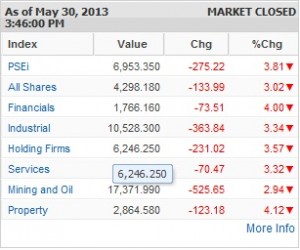
The main Philippine Stock Exchange index (PSEi) lost 275.22 points, or 3.81 percent, to close at 6,953.35. This marked the PSEi’s steepest single-day decline since Sept. 21, 2011, when the index slumped by 4.2 percent at the height of the European fiscal crisis then.
This time, however, financial markets across the globe are jittery as prospects loomed that the US Federal Reserve would temper its liquidity-inducing bond buyback program that has perked up markets across the globe.
The announcement of a 7.8-percent growth of the Philippine gross domestic product (GDP) in the first quarter initially pared down PSEi losses to about 30 points from over 100 points yesterday, but the index again widened losses afterward.
“While the GDP figure was a positive surprise, the market was not able to sustain the short knee-jerk positive reaction to the surprise GDP numbers. At the core is higher risk aversion, as evidenced by a blip in 10-year bond yields overnight,” UBS Securities Philippines said in its daily commentary.
Peso depreciation
The UBS said the depreciation of the peso—which has weakened by 3 percent against the US dollar so far this month—likewise induced the stock market pullback.
After showing higher volatility throughout trading hours on Thursday, the peso closed at 42.32 against the US dollar, up by 12 centavos from the previous day’s finish and the 11-month low of 42.44 to the greenback.
Manny Cruz, chief strategist at Asiasec Equities Inc., said it seemed that some large funds were dumping stocks from emerging markets—particularly the bloc referred to as TIP, or Thailand-Indonesia-Philippines and Mexico—and likewise selling out of Japan to shift to US dollar assets on valuation concerns.
As of the local market’s closing, the main Japanese stock index Nikkei 225 had slumped by over 5 percent.
Expensive valuation
The expensive valuation of the local stock market was likewise cited as a key factor behind the selldown. And with signs of recovery in the US economy, some global funds were moving out of richly valued markets, said Joseph Roxas, president of local stock brokerage Eagle Equities Inc.
The UBS estimated that the PSEi was now trading at a price-to-equity ratio of 21x, which means that investors are paying 21 times the amount of money index stocks are expected to make this year. In the last five years, historical valuation was only at 14-15x earnings.
“Coupled with a number of equity capital raising, this has put a cap on the market,” UBS said.
Several companies have embarked recently on large public offerings—whether an initial public offering or a follow-on offering. Rich valuations have likewise encouraged a number of companies to sell shares kept in their treasuries.
160 decliners
Value turnover at the local stock market amounted to P16.86 billion. There were 160 decliners that overwhelmed 15 advancers while 38 stocks were unchanged.
The biggest decliners among PSEi stocks were Jollibee (-7.28 percent), ICTSI (-6.45 percent) and ALI (-6.29 percent). Metrobank, SMC and URC were all down by over 5 percent while SMIC, AEV, EDC and AGI all tumbled down by over 4 percent.
Most local stocks also tumbled down ahead of the MSCI index realignment which takes effect on Friday.
Opposing pressures
At the foreign exchange market, pressures that boosted and dragged the appetite for local currency clashed as currency traders weighed indicators of an improving US economy on one hand and reports of another robust growth of the Philippine economy on the other.
The trading range was wide, with the intraday high hitting 42.22 and the intraday low settling at 42.63 against the US dollar.
The volume of trade amounted to $1.11 billion from $1.06 billion previously.
Traders said indicators showing an improving employment situation, growing retail sales, and rising consumer confidence in the United States fueled the appetite for the dollar and dollar-denominated assets.
Such indicators likewise supported speculations that the US Federal Reserve would soon temper and eventually end its stimulus program.
Flight of capital
Because portions of liquidity being injected by advanced economies normally spill over to emerging markets like the Philippines in the form of portfolio investments, talks about an end of the US Fed’s stimulus program have sparked speculations of flight of capital away from emerging markets and of depreciation of their currencies.
Projections of depreciation of emerging-market currencies, in turn, drove some fund owners to make early positions by buying dollars.
On the other hand, however, the favorable performance of and rosy projections for the Philippine economy continue to make the peso attractive.
According to the Bangko Sentral ng Pilipinas, the latest movement of the peso, which weakened to the 42-to-a-dollar territory on Wednesday, was not worrisome.
BSP Governor Amando Tetangco Jr. said the Philippines was unlikely to suffer from significant flight of capital even as the US economy improved. This is because the Philippines continued to show an encouraging economic performance, he said.
No cause for alarm
Tetangco said that an exchange rate at the 42:$1 level was no cause for concern and still reflected market confidence in the Philippine economy.
“The peso continues to be supported by fundamentals,” Tetangco told reporters.
The depreciation of the peso this week is actually a welcome development for the BSP, which had been contending with losses due to the local currency’s appreciation over the last few years.
Appreciation pressures on the peso last year forced the BSP to engage in heavy dollar buying to prevent an even steeper rise of the local currency. Huge spending led to P95 billion in net loss for the BSP last year.
The recent weakening of the peso, therefore, is seen to temper the BSP’s losses.

